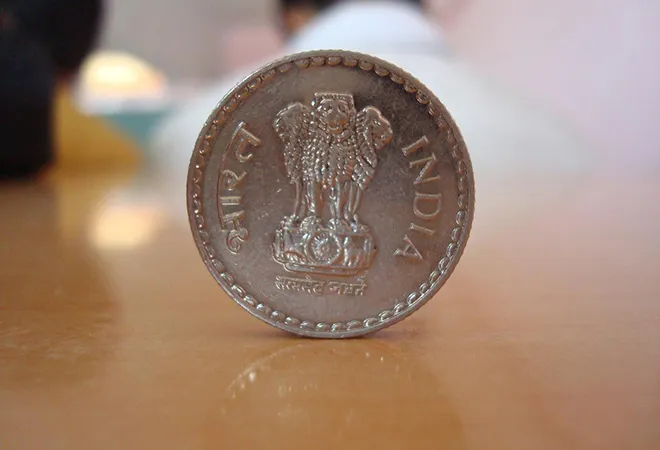-
CENTRES
Progammes & Centres
Location
The FRDI Bill creates a process, with early-warning systems in place to alert regulators and the government about the risk on financial institutions, with which to address and fix failure.

The Financial Resolution and Deposit Insurance (FDRI) Bill, 2017 proposes a mechanism, a method, a path to address potential failures in the financial sector. For a USD 2.3 trillion economy to not have such a system shows a legislative lacuna that the Bill addresses. The question then is: how does the economy manage a bank failure today? The answer, sadly, is: there is no process that a bank or its regulator Reserve Bank of India (RBI) has in place. What we do have is a casual, policy-over-the-evening-snacks approach under which the RBI nudges a large bank to take over the failing bank, as it did, for instance, in the case of the Global Trust Bank amalgamation with Oriental Bank of Commerce . Such spontaneity works for a ‘jugad’-based financial sector; it does not befit a sophisticated and modern economy.
The FRDI Bill changes all this. In a nutshell, the FRDI Bill creates a process, with early-warning systems in place to alert regulators and the government about the risk on financial institutions, with which to address and fix failure. This is important, even crucial, because finally the money at stake belongs to depositors, the money used to make good the depositors’ losses through fiscal largess belongs to citizens — the INR 211,000 crore front-loaded bank recapitalisation to clean up non-performing assets is a case in point
Through the establishment of a resolution corporation, the Bill attempts to create a framework to resolve distressed financial services providers and to provide deposit insurance to consumers. It covers banks, insurance companies, financial markets infrastructure (payments systems, depositories, clearing corporations and stock exchanges), and systemically important financial institutions (a term that captures size, complexity, volume of transactions and interconnections with other financial institutions). Why are these being resolved separately, when the Insolvency and Bankruptcy Code
Through the establishment of a resolution corporation, the Bill attempts to create a framework to resolve distressed financial services providers and to provide deposit insurance to consumers.
The reason is simple. The currency of doing business for financial firms is consumer deposits. By allocating money through complex risk-return expectations to producers, they act as intermediaries between depositors and entrepreneurs. Some of them are systemically important and their failure can disrupt the real economy. As a result, standard insolvency and bankruptcy processes that often drag on for years are not suitable for resolving financial firms. The fears of a failure, for instance, could result in a “run on the bank” even when they have not really failed
Unfortunately, what is really the first process-based failure management in the financial sector — that is, a method that lays no stress on public finances (getting taxpayers’ money to pay depositors) or on more efficient entities (a stronger bank taking over a weaker one) — is being needlessly debunked. This is being done under the garb of ‘public interest’, even when protections in the FRDI law keep the interests of the public to a higher ground, by law, than the present randomness of good intentions. Most criticism is pivoting around a ‘bail-in’ clause
In other words, the Bill proposes to give power to the resolution corporation to take part of the money of consumers (deposits in banks, for instance) to keep financial institutions afloat. This clause was put in so that “tax-funded bail-outs become less likely”, and all equally-placed claims would be written down to equal degrees, so that there is equal treatment of similarly placed creditors
The problem here is that banks will not give consumer that option. Worse, being more concerned about stability than consumer protection, there is little hope that the regulator, RBI, would ensure that bank give this option. One way to manage this problem of reluctant banks backed by a consumer-inert regulator is to give added protection to consumers by writing into the final law
The Bill provides safeguards in the form of options for depositors.. The problem here is that banks will not give consumer that option.
On the legal side, the existing protection a bank depositor gets is a maximum of INR 100,000
Which means it has risen by a compounded annual rate of 12.7% per annum over the 25 years, from 1968 to 1993. Now that another quarter of a century has passed, this number is in dire need of an upgrade. If we take the same growth rate of 12.7%, it would stand at almost INR 20 lakh. Once the FRDI Bill is enacted into law, one of the first jobs of the new corporation — the Bill proposes to repeal the DICGC Act and amendment of 12 other laws, including Reserve Bank of India Act, Banking Regulation Act, Life Insurance Corporation Act, and State Bank of India Act — must be to raise this minimum guarantee. Irrespective of when the proposed Corporation raises this limit, the government has clarified that the new Bill provides a similar protection to depositors as it exists today
In tune with the urge to place systems with which to fix financial institutions on the brink of failure, the Bill proposes objective criteria for classifying the risk to viability they face
Financial institutions would be legally bound to share this information with the ‘appropriate regulator’ (RBI for banks, IRDAI for insurance firms and so on). Only once the risk reaches ‘Material’, the Board of the Resolution Corporation enters the picture and the financial firm would provide a resolution plan within 30 days (90 days for systemically important financial institutions). Once the risk reaches ‘Critical’, the Resolution Corporation takes charge. This, without doubt, is a well-thought through Bill.
Low — probability of failure is substantially below the acceptable probability of failure. Moderate — probability of failure is marginally below or equal to acceptable probability of failure. Material — probability of failure is marginally above acceptable probability of failure. Imminent — probability of failure is substantially above the acceptable probability of failure.
But one important point that this Bill overlooks is on disclosures. While the entire edifice of this system lies on financial institutions sharing information with the regulator or the Resolution Corporation or both, all of which is being done in the name of “protecting consumers,” there is nothing in the law that says the information needs to be shared with consumers. The ostensible reason could be that if consumers come to know that if a bank has moved to moderate from low risk, there could be a run on the bank and risk to the system, even when the bank in question is safe. This argument looks down on consumers as worthless economic agents. Instead, what consumers might end up doing is what markets do on ratings downgrades — nobody rushes out to sell the bonds if a rating falls to AA from AAA.
Further, in the hyper-transparent and instant-information world of the 21st century, there is no way to prevent the knowledge of risks from percolating to the public. It is far more efficient for banks and regulators to share information than to consciously suppress it — at stake is the credibility of the entire financial system and the government. From the macroprudential perspective, disclosures are beneficial because they promote financial stability
Reserve Bank of India Notice: ‘Global Trust Bank Limited (Amalgamation with Oriental Bank of Commerce) Scheme, 2004’, 26 July 2004
The views expressed above belong to the author(s). ORF research and analyses now available on Telegram! Click here to access our curated content — blogs, longforms and interviews.

Gautam Chikermane is Vice President at Observer Research Foundation, New Delhi. His areas of research are grand strategy, economics, and foreign policy. He speaks to ...
Read More +